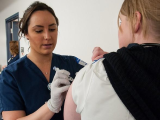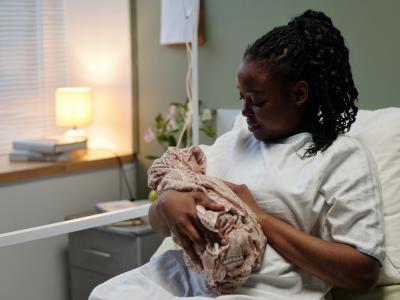Jan 11, 2013 (CIDRAP News) – An early assessment of this year's influenza vaccine shows it has provided a "moderate" level of protection at 62% so far this season, the Centers for Disease Control and Prevention (CDC) said today. That vaccine effectiveness (VE) level is about the same as in recent seasons and as found in a recent careful meta-analysis of randomized controlled trials.
"We found overall vaccine effectiveness to be 62%," said CDC Director Thomas Frieden, MD, MPH, at a press briefing. "That means if you got vaccinated you were about 60% less likely to get influenza requiring you to go to a doctor.
"Influenza vaccine is far from perfect, but it's still by far the best tool we have to prevent the flu," he added, sounding a theme that CDC officials repeatedly emphasized. They also stressed that better vaccines are greatly needed.
The announcement comes amid an early and very busy flu season, with 24 states reporting high flu activity last week. That's down from 29 states the previous week, and some other flu indicators were down a bit as well, but CDC officials said it's too early to tell if the epidemic has peaked. (See related story today, "US flu activity shifts west as some national markers drop.")
VE was estimated by four centers in the CDC's US Influenza Vaccine Effectiveness Network, located in Wisconsin, Michigan, Pittsburgh, and Texas, according to today's CDC report, an early-release article in Morbidity and Mortality Weekly Report. The researchers enrolled patients over 6 months old who sought care for acute respiratory infections from Dec 3 to Jan 2. They were asked if they had received a flu vaccine this season.
A total of 1,155 children and adults were included in the study. Of these, 416 (36%) tested positive for influenza A or B (by polymerase chain reaction); 236 (57%) of the cases were type A, and 180 (43%) were type B. All the type A viruses were subtype H3N2, which tends to cause more severe illness than other seasonal subtypes.
The researchers found that 32% of the patients with confirmed flu infections had been vaccinated, versus 56% of those who tested negative for the virus. That signals an overall VE of 62% (95% confidence interval [CI], 51%-71%) for preventing medically attended flu, according to the report.
Further analysis revealed somewhat different numbers for types A and B. The vaccination rate among type A case-patients was 37%, versus 26% among type B case-patients. The VE for type A therefore was 55% (95% CI, 39%-67%), while the VE for type B was 70% (95% CI, 56%-80%).
"Interim VE estimates indicate the 2012-13 influenza vaccine has moderate effectiveness against circulating influenza strains, similar to a summary estimate from randomized clinical trials," the report states.
It refers to a meta-analysis published in the Lancet Infectious Diseases in 2011, in which researchers estimated on the basis of randomized controlled trials that trivalent inactivated flu vaccine (TIV) is about 59% effective in working-age adults (18 through 64). The authors concluded that consistent evidence of protection in younger and older groups was lacking. Seeking to eliminate bias, they included only the most carefully designed trials in the analysis.
Because the new findings show that some vaccinated people can still contract flu, antiviral drugs should be used as recommended to treat patients regardless of their vaccination status, the CDC report says. Early antiviral therapy is recommended for patients who have a severe case or are at high risk for flu complications.
The CDC did not attempt to assess VE by age-group in today's preliminary estimate. Frieden noted that flu vaccines are more protective in young people than the elderly, adding, "Those differences are not yet fully assessed. Our basic approach is to get the information as quickly as we can and then share it openly."
Frieden was asked if he was concerned over the finding that VE was higher for influenza B than A, given that type A is more common. He replied that the sample used for the estimates was relatively small and the confidence intervals overlap. "So the data are not enough to say there's a real difference between the two different strains."
CDC officials said the current VE estimate is in line with VE figures for past years.
"We'd say that 62% vaccine effectiveness in a broad population of both healthy and elderly and sick is what we'd expect from the vaccine in a year when the circulating strains look like the strains in the vaccine," said Joseph Bresee, MD, chief of the Epidemiology and Prevention Branch in the CDC's Influenza Division.
Last year the VE estimate was in the "mid 50s," Bresee said. "If you summarize all the studies over the past 20 years, the 50% to 70% range is what you get."
In response to a question, Bresee said there are some data suggesting that those who contract flu despite being vaccinated may have a milder illness than those who are unvaccinated, but the data are "very sparse." He added that data gathered over the rest of the season may shed more light on that question.
The CDC report cautions that the final VE estimate for this season is likely to be lower than the current one, given that the VE estimates for previous seasons were reduced after researchers adjusted for potential confounding factors.
Frieden told reporters, "Sixty-two percent is far less than we wish it would be, but it's a glass half full. . . . It's well worth the effort. I get vaccinated, my family gets vaccinated, and we all hope in a few years to have a better vaccine."
The report says that age data were not available from all the VE Network sites, but one site, the Marshfield Clinic in Wisconsin, adjusted its findings for age and found that it made little difference: the unadjusted VE was 69%, and the VE with the age adjustment was 66%.
Edward Belongia, MD, director of the Epidemiology Research Center at the Marshfield Clinic Research Foundation, told CIDRAP News that his team adjusted for the fact that the age-group patterns of flu A and B differed between the vaccinated and unvaccinated patients.
Although the age adjustment made little difference overall, it did make a difference with regard to types A and B, Belongia said. The age-adjusted estimate for type A was 61%, which was about 10 points higher than the unadjusted estimate for that type. For type B, the age-adjusted VE was 69%, which was about 10 points lower than the crude estimate. He stressed that the numbers were preliminary and covered only TIV.
Today's CDC findings were welcomed by Michael T. Osterholm, PhD, MPH, senior author of the Lancet Infectious Diseases meta-analysis and of a much larger report, the CIDRAP Comprehensive Influenza Vaccine Initiative (CCIVI) report, released last October, which expanded on the earlier analysis and called for a major effort to develop better flu vaccines. Osterholm is director of the University of Minnesota's Center for Infectious Disease Research and Policy, which publishes CIDRAP News.
"This [61% VE] is pretty much what we would've expected based on our Lancet and CCIVI reports," he said.
He said the studies that produced the estimates are of high quality. "I really give the CDC great credit for coming forward with this information," he added. "Some people are surprised by the data."
"We have to keep using these vaccines because they're the best tool we have. But it sure is a clarion call again for new game-changing vaccines," Osterholm added.
In his view, the findings provide further evidence that the degree of match between the vaccine and the circulating flu strains is not a good predictor of VE.
In the 2009 H1N1 pandemic, the monovalent vaccine was very closely matched to the pandemic virus, yet VE was only about 56%, he said. And this year, when the B strain is imperfectly matched with circulating strains, the estimated VE is 70%.
(Today's flu activity update from the CDC says that two thirds of the circulating type B isolates it has analyzed so far this year match well with the B strain in the vaccine, but the other third are of the Victoria lineage, which is not in the vaccine.)
"A good match doesn't predict excellent VE, and a bad match doesn't dictate a very low VE," Osterholm said. "So it raises the question, what is the match really telling us?"
Belongia commented that his clinic is seeing "a mixture of lineage match and mismatch on [type] B, about 50-50 at this point. Despite this, we're seeing VE against B that's about as good as we ever see."
CDC. Early estimates of seasonal influenza vaccine effectiveness—United States, Jan 2013. MMWR 2013 Jan 11;62:1-4 (early release). [Full text]
See also:
Oct 15, 2012, CIDRAP News story "Complacency, misperception stymie quest for better flu vaccines"
Oct 25, 2011, CIDRAP News story "Strict meta-analysis raises questions about flu vaccine efficacy"



















